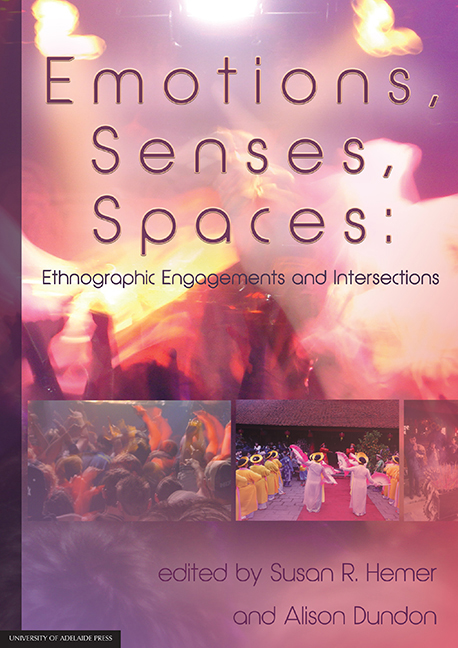Book contents
- Frontmatter
- Contents
- Biographies
- 1 Ethnographic intersections: Emotions, senses and spaces
- 2 ‘Dancing for joy’: Gender and relational spaces in Papua New Guinea
- 3 Creating the right ‘vibe’: Exploring the utilisation of space at Hip Hop concerts in Adelaide and Melbourne
- 4 Pontic dance: Feeling the absence of homeland
- 5 Emotional actors/Affective agents: Interspecies edgework and sociotechnical networks in the Spanish bullfight from horseback (rejoneo)
- 6 Sensual feasting: Transforming spaces and emotions in Lihir
- 7 Anxious spaces: The intersection of sexuality, the senses and emotion in fieldwork in Nepal
- 8 Interrupted research: Emotions, senses and social space in (and out of) the field
- 9 Voices in the park: The composition of sacred space and public place
- 10 Ngadha being-in-common: Emotional attachment to people and place in Flores, Indonesia
- 11 Trust your senses: Growing wine and making place in McLaren Vale
5 - Emotional actors/Affective agents: Interspecies edgework and sociotechnical networks in the Spanish bullfight from horseback (rejoneo)
Published online by Cambridge University Press: 25 July 2017
- Frontmatter
- Contents
- Biographies
- 1 Ethnographic intersections: Emotions, senses and spaces
- 2 ‘Dancing for joy’: Gender and relational spaces in Papua New Guinea
- 3 Creating the right ‘vibe’: Exploring the utilisation of space at Hip Hop concerts in Adelaide and Melbourne
- 4 Pontic dance: Feeling the absence of homeland
- 5 Emotional actors/Affective agents: Interspecies edgework and sociotechnical networks in the Spanish bullfight from horseback (rejoneo)
- 6 Sensual feasting: Transforming spaces and emotions in Lihir
- 7 Anxious spaces: The intersection of sexuality, the senses and emotion in fieldwork in Nepal
- 8 Interrupted research: Emotions, senses and social space in (and out of) the field
- 9 Voices in the park: The composition of sacred space and public place
- 10 Ngadha being-in-common: Emotional attachment to people and place in Flores, Indonesia
- 11 Trust your senses: Growing wine and making place in McLaren Vale
Summary
Abstract
Latour (1993) describes an ongoing human preoccupation with ‘purification’ from categories such as technology from society, nature from culture and human from animal. He identifies a certain irony in that such processes of purification simultaneously enable a proliferation of hybrid states of being: those that fall between the conceptual gaps. One enduring hybrid of Classical Greek mythology is the centaur — half man, half horse. The centaur metaphor is frequently used to describe a state of interspecies intercorporeality referred to in descriptions of horseriders thinking, feeling and moving ‘as one’ with their horse. However, there is a need to interrogate the centaur metaphor for human‑horse intercorporeality by examining the dimensions through which it is generated — not only those of human and animal, but also technology, space and senses. This chapter considers these dimensions by applying an Actor Network Theory approach to the ethnographic example of the mounted bullfight. In so doing, space, technology and emotion (through tension) are acknowledged for having agency alongside and through the horse and rider. Through a careful consideration of the progression of a typical mounted bullfight event, the sociotechnical relations between these ‘actors’ can be seen to intensify to such an extent that tension cannot be overlooked. In fact, the integral role of tension in the mounted bullfight performance requires a consideration of the agency of emotions in networks. This discussion is framed by the concept of ‘edgework’ (Lyng 1990), making it possible not only to more fully describe the sociotechnical relations of the human‑animal relations in the mounted bullfight, but also to convey how those relationships are felt and experienced by bodies in space, over time.
Introduction
Latour's (1993) early work identified the ironic proliferation of ‘hybrids’ that arise from, and are made possible by, attempts to purify categories such as ‘human’ and ‘animal’. The centaur is one mythological hybrid that has been used both poetically (Pineda Novo 1988) and academically (Thompson 2011; Game 2001) to describe intercorporeal relationships between horses and riders.
- Type
- Chapter
- Information
- Emotions, Senses, SpacesEthnographic Engagements and Intersections, pp. 67 - 90Publisher: The University of Adelaide PressPrint publication year: 2016



